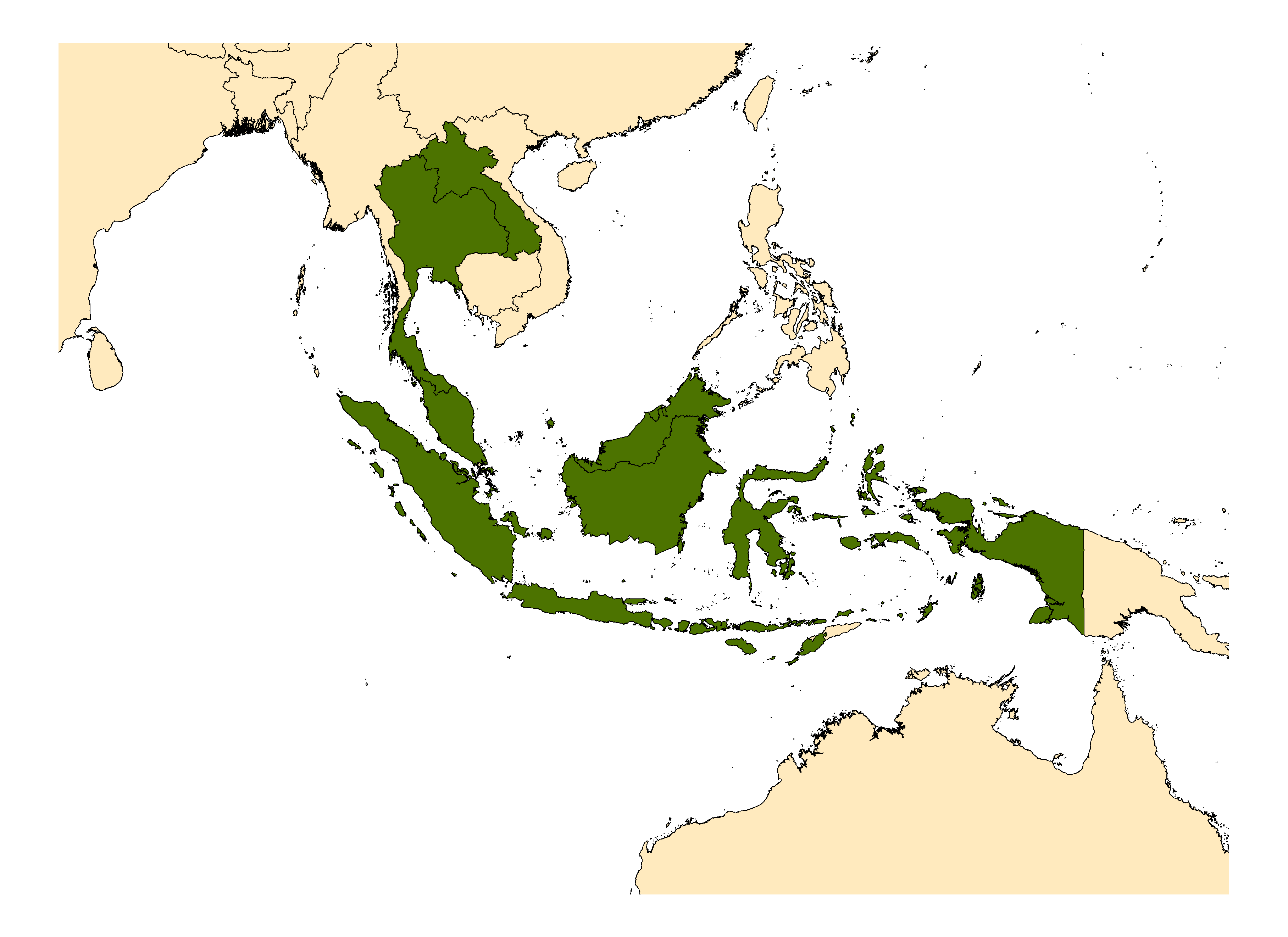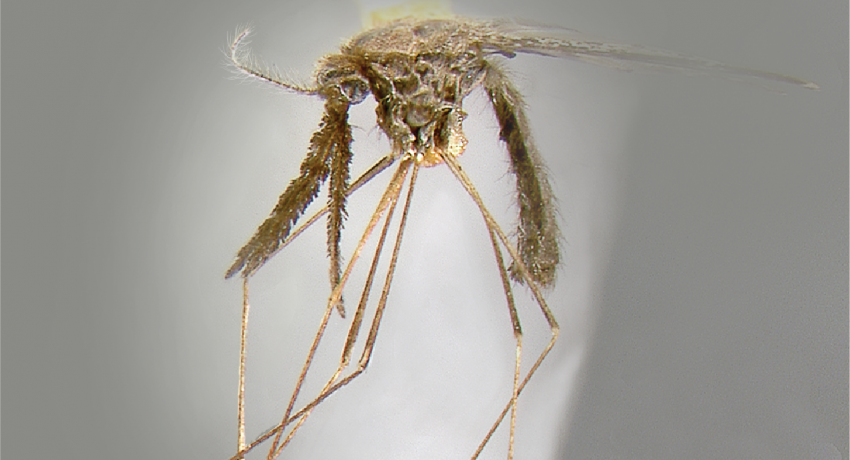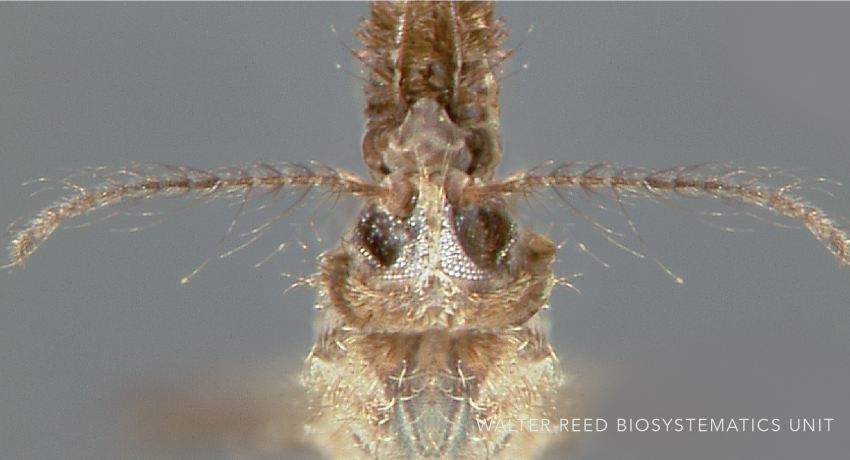ORIENTAL REGION
Etymology: Donald Colless
Anopheles donaldi, named in honor of Donald Colless, is one of 12 species belonging to the diverse Oriental Barbirostris Group. Anopheles donaldi is placed within the Barbirostris Subgroup, along with An. franciscoi Reid, An. hodgkini Reid, An. pollicaris Reid, and the six members of the Barbirostris Complex (An. barbirostris van der Wulp, An. campestris Reid, An. dissidens Taai & Harbach, An. saeungae Taai & Harbach, An. vanderwulpi Townson & Harbach, and An. wejchoochotei Taai & Harbach). Like other members of the group, An. donaldi is most easily differentiated at the egg stage. Females can also be distinguished as adults using the following diagnostic characters in the adults: pale accessory spot on wing fringe at R2, narrow pale bands on Ta-II and broader pale bands on Ta-I, and by numerous pale scales on the abdominal sterna.
Like other members of the group, An. donaldi is most easily differentiated at the egg stage. Females can also be distinguished as adults using the following diagnostic characters in the adults: pale accessory spot on wing fringe at R2, narrow pale bands on Ta-II and broader pale bands on Ta-I, and by numerous pale scales on the abdominal sterna.
Type locality: 14th mile Puchong-Klang Road, Selangor, Malaya [Malaysia]
Type depository: Natural History Museum, London, England (NHMUK)
DIAGNOSTIC CHARACTERS (Click photos to view; mouse over and click large photo to zoom in.)
ADULT (illustrated): Head: Flm1 only with pale scales. Clypeus without dark scale patch. Wing: Costa without presector pale spot or preapical pale spot; wing apex with 3 small pale spots, center spot near end of vein R2. Legs: First pale band on Ta-I about as long as Ta-I5. Fe-III without a preapical pale band; Ta-II1–5 with narrow apical pale bands. Abdomen: I–VI-S each with ≥20 median pale scales; VII-S with tuft of dark scales.
LARVA (not illustrated): Head: Seta 1-A with long branches; seta 2-C closely approximated; seta 3-C many-branched, broom-like; seta 9-C 5–11 branched. Abdominal segments: Seta 1 palmate, fully developed on most segments; seta 1-II palmate, usually pigmented; seta 1-P with ≥4 branches.
TAXONOMIC KEYS
Reid 1968
Rattanarithikul & Harrison 1973
Rattanarithikul et al. 2006b
![]()
WRBU - Anopheles - Myzomyia - IndoMalay - Adult
![]()
WRBU - Anopheles - Myzomyia - IndoMalay - Larva
![]()
WRBU - Anopheles - Myzomyia - Oriental - Adult
![]()
WRBU - Anopheles - Myzomyia - Oriental - Larvae
![]()
WRBU - Genera - Global - Adult
![]()
WRBU - Genera - Global - Larva
![]()
WRBU - Anopheles Subgenera and Series - Indomalaya - Adult
![]()
WRBU - Anopheles Subgenera and Series - Indomalaya - Larva
![]()
WRBU - Anopheles Subgenera and Series - Oriental - Adult
![]()
WRBU - Anopheles Subgenera and Series - Oriental - Larva
![]()
WRBU - Genera - Indomalaya - Adult
![]()
WRBU - Genera - Indomalaya - Larva
![]()
WRBU - Genera - Oriental - Adult
![]()
WRBU - Genera - Oriental - Larva
Exemplar DNA sequences
None
BIONOMICS
Immatures
Immature Anopheles donaldi are found in shaded or heavily vegetated fresh water ground habitats, such as jungle pools, river and sedge swamps, swamp forest, are known to include rice fields and river swamps, jungle pools, swamp forest, sedge swamps, rice fields and overgrown drainage canals.
Adults
Anopheles donaldi are associated with jungle-fringe habitats in hilly areas, and swamps with dense tree cover in lowland sites. Anopheles donaldi is an important localized vector of human malaria especially in Borneo. In Sabah, Anopheles donaldi has replaced An. balabacensis as the main malaria vectors in Kinabatangan, due to prolific deforestation in the region. Anopheles donaldi comprised 22.8% of all Anopheles found in traditional Dayak longhouses in Sarawak, and were the dominant Anopheles species (49.9%) captured in farm settings, with sporozoite rates of 0.23%. By contrast few An. donaldi were collected at man and monkey baited traps set in deep forest. The species is highly anthropophilic, but most likely also feeds on domestic animals and wildlife. It is endophilic, and will invade houses in search of blood meals at night. Resting females in shady jungle sites can also be enticed to feed during the day.
DISTRIBUTION NOTES
Indonesia, Laos, Malaysia (including Sarawak, Borneo), Thailand

WRBU VECTOR HAZARD REPORTS
None; View other WRBU Vector Hazard Reports
Available GIS Models:
None
IMPORTANT REFERENCES (full citations below)
Peyton & Scanlon 1966: 1 (F*; distribution)
Reid 1968: 132 (M*, F*, P, L, E*; keys, bionomics)
Harrison & Scanlon 1975: 94 (M*, F*, P*, L*)
Reid 1980 (taxonomy)
Rattanarithikul & Harrison 1973 (L; key, Thailand)
Rattanarithikul et al. 2006b (F*, L*; bionomics, distribution, keys)
Tan et al. 2008 (bionomics, simian malaria)
Suwonkerd et al. 2013 (bionomics, medical importance)
CURRENT SYNONYMS
None
CITED REFERENCES
Harrison, B.A., & Scanlon, J.E. (1975). Medical entomology studies-II. The subgenus Anopheles in Thailand (Diptera: Culicidae). Contributions of the American Entomological Institute, 12(1), iv + 1–307.
Peyton, E.L. & Scanlon, J.E. (1966). Illustrated key to the female Anopheles mosquitoes of Thailand. U.S. Army Medical Component, SEATO, Bangkok, Thailand. 47pp.
Rattanarithikul, R., & Harrison, B.A. (1973). An illustrated key to the Anopheles larvae of Thailand. U S Army Medical Component, SEATO, Bangkok, Thailand.
Rattanarithikul, R., Harrison, B.A., Harbach, R.E., Panthusiri, P., & Coleman, R.E. (2006b). Illustrated keys to the mosquitoes of Thailand. IV. Anopheles. Southeast Asian Journal of Tropical Medicine and Public Health, 128(Supplement 2), 2.
Reid, J.A. (1968). Anopheline mosquitoes of Malaya and Borneo. Studies from the Institute for Medical Research Malaysia, 31, 1–520.
Reid, J.A. (1968). Anopheline mosquitoes of Malaya and Borneo. Studies from the Institute for Medical Research Malaysia, 31, 1–520.
Reid, J.A. (1980). Anopheles donaldi: Some recollections and speculations. Medical Journal of Malaysia, 34(4), 399–402.
Suwonkerd, W., Ritthison, W., Ngo, C.T., Tainchum, K., Bangs, M.J., & Chareonviriyaphap, T. (2013). Vector Biology and Malaria Transmission in Southeast Asia. Anopheles mosquitoes - New insights into malaria vectors (pp. 273–325). Janeza Trdine 9, 51000 Rijeka, Croatia: InTech.
Tan, C. H., Vythilingam, I., Matusop, A., Chan, S.T., & Singh, B. (2008). Bionomics of Anopheles latens in Kapit, Sarawak, Malaysian Borneo in relation to the transmission of zoonotic simian malaria parasite Plasmodium knowlesi. Malaria Journal, 7, 52.
CITE THIS PAGE
Walter Reed Biosystematics Unit (Year). Anopheles donaldi species page. Walter Reed Biosystematics Unit Website, http://wrbu.si.edu/vectorspecies/mosquitoes/donaldi, accessed on [date (e.g. 03 February 2020) when you last viewed the site].










































































































































































